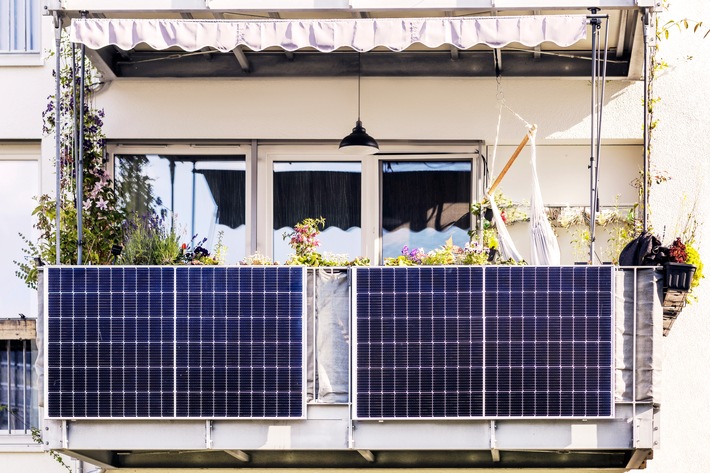 Sonnenkollektoren auf dem Balkon eines Wohnblocks. Haus-Solarmodul. Moderner Solar-Balkon. Balkonkraftwerk / Weiterer Text über ots und www.presseportal.de/nr/109388 / Die Verwendung dieses Bildes für redaktionelle Zwecke ist unter Beachtung aller mitgeteilten Nutzungsbedingungen zulässig und dann auch honorarfrei. Veröffentlichung ausschließlich mit Bildrechte-Hinweis.
Sonnenkollektoren auf dem Balkon eines Wohnblocks. Haus-Solarmodul. Moderner Solar-Balkon. Balkonkraftwerk / Weiterer Text über ots und www.presseportal.de/nr/109388 / Die Verwendung dieses Bildes für redaktionelle Zwecke ist unter Beachtung aller mitgeteilten Nutzungsbedingungen zulässig und dann auch honorarfrei. Veröffentlichung ausschließlich mit Bildrechte-Hinweis.
Balcony power plants: The future of decentralized power generation?
13. April 2023 Published by Raphael DoerrGermans are opting more and more for renewable energies and want to do their bit to protect the climate. Balcony power plants are very much in vogue – they are inexpensive to purchase, are subsidized by policymakers and are suitable for rented apartments, meaning they can reduce electricity costs effectively. We answer the most important questions about the small, high-yielding energy systems.
How does a balcony power plant work?
A balcony power plant generates electricity from solar energy and feeds it directly into your own grid. The solar panels on your balcony, on the wall of your house, in the garden or on the garage roof allow you to reduce your own electricity consumption and save money in the long run. Moreover, you help protect the climate because the electricity comes from renewable sources and therefore does not produce any CO2 emissions.
The generated electricity needs to be consumed immediately since there is no means of storing it. However, particularly devices that consume electricity all the time, such as the monitor in your home office, refrigerators and freezers, the WLAN router or devices in standby, can at most be run at neutral cost during the hours of sunshine. Up to 600 watts peak (Wp) are permitted.
What components do I need?
A balcony power plant usually consists of one or two solar panels and an inverter. The solar panels capture the sun’s rays and convert them into direct current. The inverter turns the direct current into alternating current, allowing it to be fed into your own power circuit. The prerequisite is an electricity meter with what is termed a backstop. Networked inverters that, for example, transmit the amount of electricity fed into the grid to an app via WLAN are now available.
How do you set up a balcony power plant?
A balcony power plant is relatively easy to connect up, even for laypersons. First, the solar panel is fixed in place – suitable brackets for the solar panels for house walls, for balcony railings and for setting them up in the garden or on garage roofs can be found in the Internet. The inverter is then connected to your own power grid. As a rule, this is done using a normal CEE 7/3 socket; if you register the plant with the local power utility, the provider will usually help. If you live on the second floor upwards, only lightweight panels without glass may be installed.
Is that possible if I rent an apartment?
In principle, yes, but it is advisable to obtain the landlord’s consent. You should also make sure that the solar panel is attached in such a way that it doesn’t damage the rented apartment.
How much do balcony power plants cost and are there subsidies available for them?
The cost of balcony power plants varies depending on their size and power. They usually cost between 500 and 1,000 euros. There are support programs that subsidize the purchase of a balcony power plant. Since January 2023, the 19 percent value-added tax has been scrapped on them and there are regional initiatives: Munich, for example, subsidizes balcony power plants at 40 cents per watt peak. In Düsseldorf, 50 percent of the purchase costs – but a maximum of 600 euros – are subsidized. And Jena bears 25 percent of the costs, up to 200 euros.
How much electricity can I save?
Inverters with a maximum of 600 watts peak are permitted for balcony power plants. If the balcony power plant produces electricity at full load, this energy can be used immediately for consumers in the household. You can save up to 130 euros a year and the plant pays for itself within five to eight years – after that, a balcony power plant supplies electricity free of charge. You can make additional savings by changing your usage behavior: If the dishwasher runs in the morning and the washing machine is programmed to start at lunchtime, your electricity costs will go down. The big winners are those who know exactly how much electricity they consume.
Measure your own power consumption reliably
Smart plugs are among the declared favorite products in the smart home. Some models additionally feature an energy metering function, as with the Gigaset Plug 2.0: The compact adapter can be integrated into the Gigaset Smart Home system and displays the energy consumption of the connected device on the free app. “That means power guzzlers in the home are soon identified and can either be replaced or used more carefully,” says Franka Abraham, Senior Product Manager Smart Home at Gigaset.
Conclusion
Balcony power plants can be a sensible addition as part of decentralized power generation. They are relatively easy to install, can also be used by tenants, and help you reduce your own electricity consumption and do your bit to protect the climate. Smart plugs with a metering function, such as the Gigaset Plug 2.0, track the power consumption of devices in the home and increase energy awareness.
 Comments
Comments
 en
en 







